With smart design and performance that rivals desktop workstations, this unit is especially well suited for mid-level CAD.
By Alex Herrera
Since its introduction in the first quarter of 2011, Intel’s new Sandy Bridge microarchitecture has permeated the notebook and desktop lines of PC OEMs worldwide. That’s to be expected, as any time Intel has rev’d a new processor or platform in the past, OEMs like Lenovo have quickly followed with new models across the board. But with Sandy Bridge, the roll-out of OEM products has been a little different, and it has everything to do with the new microarchitecture’s signature new feature: CPU-integrated graphics processors.
For the previous Westmere generation, the CPU and GPU were implemented on a separate die, and as a result the company could market a range of Core and Xeon branded SKUs on day one, some of which were CPU-only and some in which the CPU and GPU were integrated in the same package. Workstation OEMs could then conveniently choose which SKUs made sense for which of their workstation models. The vast majority of shipping workstations do so with discrete GPUs, so OEMs generally chose those processor SKUs that omitted the graphics die. After all, why pay for internal circuitry that would be superseded by an external chip?
However, with Sandy Bridge’s die-integration of CPU and GPU, all of the company’s first round of SKUs contain integrated GPUs. And that lack of any GPU-less Core and Xeon SKUs begged the question as to whether workstation OEMs would rev new models right away—and if so, which ones — or wait for subsequent SKUs (expected in the second half of 2011) that drop the integrated GPU in favor of more x86 cores.
Low-end deskside workstations made sensible deployment vehicles for Sandy Bridge CPU + GPU parts, as they represent the most cost-sensitive segment in the market. And while Sandy Bridge’s integrated GPU is no world-beater, it has dialed up performance substantially from previous generations, so much so that for this set of products Intel is for the first time actively marketing the graphics for entry-level workstation use on select Xeon SKUs. (Hence, the P3000 graphics branding, where the “P” stands for Professional.) And sure enough, we saw every major OEM come out with a Sandy Bridge upgrade on its lowest-end machines.
But low-end desksides aren’t the only workstations that made good vehicles for the first round of Sandy Bridge. Mobile workstations can also take advantage of Intel’s Processor Graphics, even though they ship with discretes. To conserve power, mobile workstations can exploit the processor graphics when performance demand is low. Nvidia’s hybrid integrated/discrete graphics solution is called Optimus, which the company rolled out in conjunction with Huron River, Intel’s primary mobile platform designed for Sandy Bridge.
After a well publicized (but in retrospect relatively benign) delay, Sandy Bridge launched in early 2011, triggering refreshes of mobile workstation models from every major vendor, including Lenovo. The company’s W520 mid-range mobile delivers incrementally more of the usual stuff we expect in an upgraded mobile workstation—faster CPU, more memory, higher-fidelity display and higher capacity storage. The W520 ships with a range of Core i7-2000 and Core i5-2000 (all Sandy Bridge) CPU options, a bumped-up max of 32 GB DDR3 and storage that includes SSD and RAID options.
How’s the new model stack up to previous models? Thanks to Lenovo, we got to find out, as the company dropped a well-equipped model on our doorstep for review. Like all major OEMs workstation offerings, be they deskbound or mobile, our W520 could be customized by selecting from a variety of CPUs and GPUs, as well as memory, storage and a few special Lenovo options like a color calibrator and fingerprint reader. Ours essentially came in the maximum possible performance configuration, with upgrades in CPU (a fast 2.5 GHz, 8 MB L3 Sandy Bridge Core i7) and GPU (Nvidia’s Fermi-based Quadro 2000, a mid-range step up from the Quadro 1000).
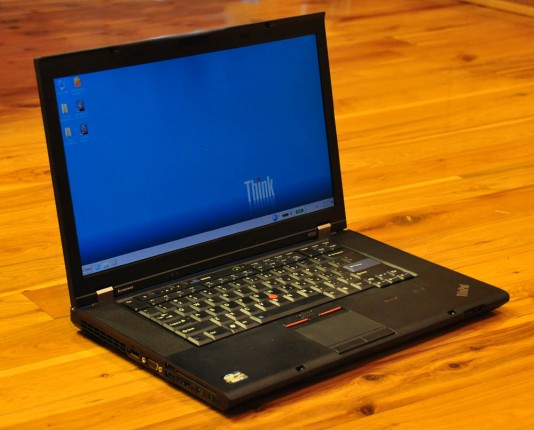
| W701 / W701ds | W520 | ||
| Display | 17″ WUXGA (RGB LED) 100% Gamut, Brightness 280nit17″ WXGA+ (LED), Brightness 200nitIntegrated 2nd Display – 10.6” WXGA LED (ThinkPad W701ds only) | 15.6″ HD, HD+ or FHD 15.6″, 16:9 LED-backlit | |
| CPU | Intel Core i7-920XM (2.0 GHz, 8MB L3), i7-820QM (1.73 GHz, 8MB L3), or i7-720QM (1.6 GHz, 6MB L3) | Intel Core i7-2000 and Core i5-2000 series (Sandy Bridge) | |
| Chipset | Intel QM57 | ||
| Graphics | Nvidia Quadro FX 2800M or 3800M (1 GB) | Nvidia Quadro 2000M (2 GB) or 1000M (2 GB), with Optimus technology to exploit Sandy Bridge processor graphics | |
| Memory | Up to 16GB of DDR3-1333, 4 So-DIMM slots | Up to 32 GB DDR3 (4 slots) | |
| OS | Windows (family) | ||
| Wireless | WLAN/WWAN | ||
| Storage | SATA 2.5″ – 9.5MM 5400rpm; 160, 250, 320, (640 ASYNC) 7200rpm, 320, 250 FDE, 500SSD 80 (Intel), 128 | 160GB (7200RPM SATA) 250GB (5400RPM SATA 250GB HDD 7200 RPM FDE 320GB (5400/7200RPM SATA) 500GB (7200RPM SATA) | |
| Camera | 2MP high sensitivity | ||
ThinkPad W701 and W520 mobile workstation specifications. (Source: Lenovo)
Top off those key components with 16 GB of 1333 MHz DDR3 memory and our MSRP (from Lenovo’s website, sampled on Sept. 1, 2011) was no entry price, but a heftier—but quite reasonable given the sales incentives at the time — $2,861. And while that price tag is quite justifiable, given what you’re getting, keep in mind that it sells for about twice what the average mobile workstation does. And we’re talking Lenovo’s lower-end W500 series here, not the upper-end W700.
| Component | |||
| CPU | Intel Core i7-2920XM @ 2.5 GHz with 8 MB L3 | ||
| Memory | 16 GB of 1333 MHz DDR3 | ||
| Disk |
|
||
| Graphics | Nvidia Quadro 2000M + Intel HD | ||
| OS | Windows 7 Professional x64 | ||
| Display | 15.6″ HD (1920 x 10800), LED backlit | ||
| Camera | Integrated 720p | ||
| Battery | 9 cell (93 Wh) | ||
| MSRP | ~$2,861 |
Configuration specifications for our Lenovo W520 review machine. (Source: Jon Peddie Research)
Storage was the only area our W520 looked even remotely pedestrian. Our model came equipped with a capable 500 GB SATA drive (non-RAID, though the W520 does support modes 0 and 1), as opposed to a much more expensive solid-state model.
Beyond the reliability and performance promised through things like RAID storage and ISV certification, the W520 continues support for some of the company’s differentiated mobile workstation features. For example, a trickle-down optional feature the W520 inherited from the W700 series is a color sensor just below the space bar. When the lid is closed, the display goes through a series of test colors and patterns. The sensor monitors the sequence and calibrates the screen to be as accurate as possible.
To maximize system security, the W520 support the Integrated Fingerprint Reader and Embedded Security Subsystem, replacing username and password with a finger swipe. Registering a minimum of two fingerprints allows the user to log on without the password. Getting a solid fingerprint registered takes a few iterations, as the system wants to make sure the finger swipe results in capture of a solid image, one to match subsequent swipes. Complementing the security features is Computrace Complete software (implemented in the BIOS), which promises to help monitor, protect and recover lost or stolen machines.
And if you truly represent the hard-core contingent—say an in-the-field oil/gas interpreter—you’ll be happy to know the W520 isn’t just professional-caliber, it’s combat caliber, rugged to MIL-SPEC standards.
Middle-of-the-road clunky is a good thing
Nobody in their right mind is buying any mobile workstation for the appealing form factor. Mobile workstations quite justifiably are all going to be on the heavier and bulkier side to varying degrees. They have to be, to accommodate big screens, more components (e.g. the discrete GPU) and all that power consumption (more volume, more fans, bigger AC adapters and batteries). And they’re not looking for minimal noise, either, as the fans and airflow necessary mean other machines will be quieter.
All that’s OK, because what the mobile workstation delivers is something no other mobile can touch, and that’s on-the-road performance and reliability that can approach what the deskside machine back at the office can. Some level of additional weight, bulk and noise are unfortunate but justified downsides to the unique benefits of mobile workstations.
That said, how much bulk, weight and noise you have to accept will vary, pretty much directly as a function of how much screen area and performance you have. And from that respect, the W520 is a reasonable compromise. At 5.95 lbs., it’s not going to be confused with a sleek corporate notebook, but it’s nothing like some monstrous mobile machines we’ve seen, like military-style luggables and Eurocom’s desktop-replacement Panther. It’s middle-of-the-road clunky with noise levels that are quite tolerable, and in this context, that’s pretty good.
Plentiful I/O
It is hard to satisfy everyone with I/O on a mobile form factor, as a designer is likely going to disappoint one way or the other. Put in too many ports, and it gets confusing and interferes with form factor and aesthetics. Put in too few, and some users will undoubtedly get frustrated. And even if you dial in the exact right number and combination, the chances a builder puts them in the locations to meet the preferences of all is pretty much zero.

For external display, there’s the old and unfortunately-still-pervasive VGA connector and the new-but-not-yet pervasive DisplayPort, in lieu of HDMI. We understand why HDMI isn’t there, and Lenovo’s not alone in omitting support. But still, with the number of big screens out there that support HDMI and not DisplayPort, we’d love to see HDMI as well. That said, adapters exist to get from DisplayPort to HDMI, so all in all, it’s not a big issue.
Three USB ports, including two supporting the most recent USB 3.0 SuperSpeed standard on the side. Lenovo didn’t confirm, but since Intel’s Sandy Bridge platform (Huron River) doesn’t natively support 3.0—that’s expected in the upcoming Ivy Bridge—we assume Lenovo populated the NEC USB 3.0 interface chip.
There’s the obligatory eSATA, for external storage expansion, as well as Gigabit Ethernet (which we’d prefer in the back rather than the side, but maybe that’s just us). Some will find the IEEE 1394 FireWire interface still valuable.
Benchmarking the W520
To get a sense of the performance these two can deliver, we employed some of the same basic tools we have in the past, as well as one very welcome new addition. We tapped SPEC’s Viewperf 11 to isolate the stress on the graphics, and we used SPECapc, Cadalyst and Cinebench tests to get a handle on how well the cards support whole-system performance. Choosing among the SPECapc suite of benchmarks, we chose Lightwave and 3ds max, representing two popular applications used in digital content creation (DCC) and CAD.
The latter was especially useful, as the latest version, SPECapc for 3ds max 2011 has been updated. Improvements include new models and test cases, a cleaner and enhanced user interface, and most importantly, compatibility with more recent versions of both 3ds max (2011) and Windows (both 32 and 64-bit Windows 7).
We find SPECapc tests to be some of the better—though far from perfect or conclusive—indicators of how a system will perform in professional applications, and SPEC’s Viewperf tests effectively isolate the rendering load on the cards themselves. Viewperf performs very little in the way of CPU computation (basically just making a bunch of OpenGL calls), thereby ensuring that it’s ultimately the video card that’s the bottleneck, not the CPU, memory or I/O.
Assessing the graphics with Viewperf 11
Where 1280 x 1024 used to be a reasonable common denominator for setting resolution, we’re now pushing to 1920 x 1080, as the resolution is now generally pervasive and supported by most moderately priced monitors. We ran Viewperf 11 on the W520 with three iterations in 1920 x 1080 resolution.
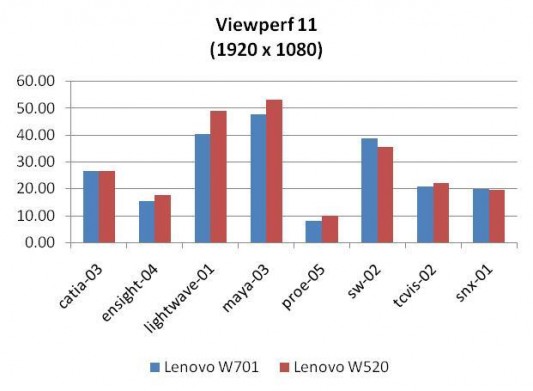
In Viewperf we’re mostly measuring the capability of the GPU, not the whole system. In that context, the results for the W520 stand in interesting contrast with Lenovo’s W701 we benchmarked one year prior. How would the current mid-range Lenovo workstation with the latest-and-greatest mid-range Nvidia Quadro GPU perform against the older high end workstation with Nvidia’s previous-generation high end Quadro FX 3800? Which was faster, the older high end graphics, or the new mid-range?
In Viewperf we’re mostly measuring the capability of the GPU, not the whole system. In that context, the results for the W520 stand in interesting contrast with Lenovo’s W701 we benchmarked one year prior. How would the current mid-range Lenovo workstation with the latest-and-greatest mid-range Nvidia Quadro GPU perform against the older high end workstation with Nvidia’s previous-generation high end Quadro FX 3800? Which was faster, the older high end graphics, or the new mid-range?
| Lenovo W701 with Quadro FX 3800M | Lenovo W520 with Quadro 2000M | W520 speedup | |
| catia-03 | 26.50 | 26.65 | 1% |
| ensight-04 | 15.31 | 17.73 | 16% |
| lightwave-01 | 40.33 | 48.99 | 21% |
| maya-03 | 47.84 | 53.13 | 11% |
| proe-05 | 8.20 | 10.14 | 24% |
| sw-02 | 38.70 | 35.73 | -8% |
| tcvis-02 | 20.79 | 22 | 6% |
| snx-01 | 19.89 | 19.44 | -2% |
The current-generation W520 delivers more graphics performance than the previous generation’s top-end W701. (Source: Jon Peddie Research)
But in the viewsets that are obviously graphics-engine dependent, the Quadro 2000 outperformed the FX 3800 in the 15% – 25% range. And that’s a range that generally feels about right moving from one generation to the next, considering we’re comparing mid-range and high end. So with our W520, we’re essentially getting substantially faster rendering at a lower price, just about one year later.
Running system-level SPECapc tests for Lightwave and 3ds max, as well as Cadalyst and Cinebench, allowed us to conduct two exercises. One, we were able to compare how well the new mid-range W520 would compare against the previous generation’s top-end W701. And two, we could compare how well a nearly $3,000 mobile workstation could compare to a modestly more expensive ($3,500-ish) deskside.
SPECapc Lightwave 9.6
The results for Lightwave were pretty much what we expected, given the nature of the benchmark. The Multi-task component naturally scales well with the number of cores, and since the hex-core CPU of the Z800 offers 50% more processors (running at faster clock speeds) than the W520, the former machine triumphed, not surprisingly. The Interactive score is influenced by the CPU as well, but the GPU tends to play a substantial role, and again the superiority of the deskside processors showed through.
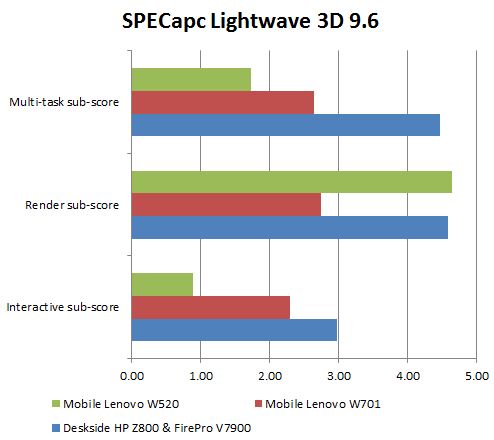
The lower CPU-dependent scores of the W520 aren’t a sign of a poor design, but the result of the very sensible trade-off a designer of a mid-range mobile will make as compared to a high-end mobile or deskside. The mobiles don’t want to sacrifice the power consumption to match the number of cores or GHz of the deskside; it just doesn’t make sense. And along those lines, a mid-range mobile will want to lean a bit more to the Watts side of things than the performance, hence the W520’s more modestly clocked cores.
But check out that Render sub-score, where our mobile W520 bested not only the previous generation W701, but the big, bad Z800 as well. How’s that possible? Well, first off it’s worth pointing out that despite its name, the Render component doesn’t leverage the GPU’s hardware engine, but rather renders in software. So the Z800’s faster GPU doesn’t help. But what does help when it comes to CPU-based rendering is memory size, and the W520 populates more than either its mobile predecessor or the more expensive deskside. Lots of memory is almost always a very good thing.
SPECapc 3ds max 2011
Next up was SPECapc 3ds max 2011, a much-appreciated upgrade to the old benchmark for 2009. The updated version supports 64-bit Windows 7 and the user interface is a pleasure to use. With 3ds max, we could compare only against the deskside Z800, and as we’d expect, the AMD FirePro V7900-equipped Z800 soundly thumped the W520 in the Hardware Shaders component.
Not a fair fight, you say? Well, yes and no. No, we wouldn’t expect the W520 to match the Z800, as from a technology standpoint, they’re apples and oranges. But from a buyer’s standpoint, it can be a very fair comparison, since they’re not priced all that far apart.
And keep in mind, there are both workstation buyers and sellers that are considering mobile workstations as deskside replacements. And if you’re one of those, you’ll be very interested to know what you might give up on the performance side to get the mobility, dollars relatively equal.
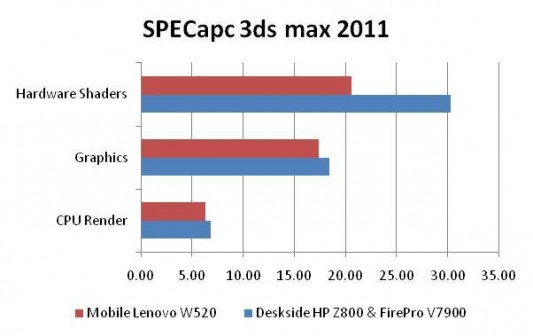
In the Graphics and CPU Render sub-tests, however, the W520 was not very far behind the Z800. As the name implies, CPU Rendering focuses on the CPU, and we’d have expected a larger gap, with the Z800’s faster hex-core Xeon out-muscling the W520’s slower quad-core.
The close scores are not only a feather in the W520’s cap, but they’re good reminder that in this day of multi-core architectures, the performance gains are only as good as the software’s use of multi-threading allows, as well as what the rest of the hardware system can sustain. We know that a portion of the CPU Rendering sub-test uses raytracing which theoretically scales with as many cores as the hardware makes available. But other portions likely don’t, so averaging out, the quad-core W520 ends up darn close. Furthermore, the most-scalable code, the raytracer, tends to be a memory hog, and worse, its performance does not scale gracefully with memory size. Here again, the W520’s larger system memory may make up for the fewer, slower x86 cores.
Either way, it shows that with the right balance of CPU, GPU and system memory, a capable mobile workstation like the W520 can deliver an experience that doesn’t have to be a huge step down from the deskside.
Cadalyst 2011
For a mid-range mobile, perhaps the most interesting benchmark is Cadalyst 2011, which gives an indication of the system-level performance a user might see with the world’s most popular CAD application, AutoCAD. What makes it especially applicable in our context is that, as a mid-range model, the W520 is going to have particular appeal to the AutoCAD user community.
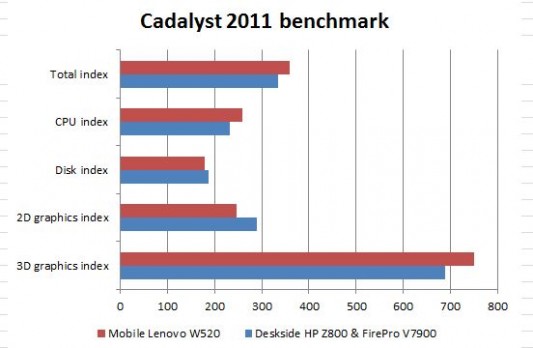
So how did the W520 fare? Pretty darn well, as it exceeded the Z800 in the three highest profile metrics: CPU index, 3D graphics index and Total Index. It did so well, in fact, that our results will surely provide fodder for those proponents of using mobile workstations not to complement desksides but replace them. Now we don’t agree that mobiles make suitable replacements for the workstation user base in any broad sense, but there are pockets of the market where the potential holds more promise. The AutoCAD-heavy AEC (Architecture/Engineering/Construction) and BIM (Building Information Modeling) spaces are good examples.
First off, many AutoCAD users are already using mobiles, just more likely corporate or consumer-branded notebooks, not workstations. Second, while mainstream AutoCAD use does benefit from many of the features of professional-caliber workstation graphics, it doesn’t tend to be a real performance hog compared to other segments. And that’s something the Cadalyst results reflect. So configuring and marketing a W520 for AutoCAD makes all kind of sense (though we imagine most buyers in this segment will outfit one for well below the near $3K price tag of our test machine.)
Cinebench 2011
Rounding out our test suite was Cinebench, which renders a 3D sequence (currently, a car chase through town) utilizing both CPU and GPU resources. It reports a composite performance number for both CPU (CPU) and graphics (OpenGL). Since the rendering is performed through OpenGL, in this case the graphics score does reflect to a significant degree on the capability of the GPU.
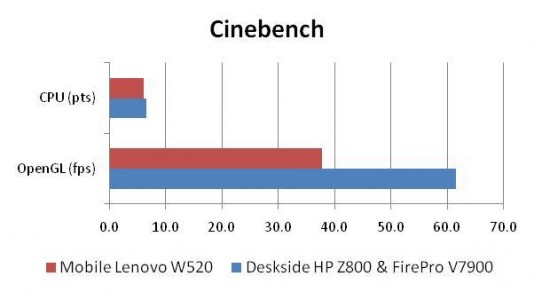
Cinebench’s CPU sub-test gave a slight edge to the Z800’s faster hex-core Xeon, but the margin was negligible. The big edge came in the OpenGL test where the Z800’s FirePro V7900 man-handled the W520’s Quadro 2000. And that’s OK, because one’s a high-end add-in card and the other a mid-range mobile module, and that’s not a fair fight for the standpoint of GPU vs. GPU.
But when it comes to comparing the whole system, again we think it’s fair from the standpoint that a user will buy one for around $3K and the other for a little bit more. It’s worth knowing what the relative delta in dollars can deliver.
Workstation-caliber performance on the road
Back in 2005, Lenovo got a serious headstart in mobile workstations, courtesy of its acquisition of IBM’s industry-leading ThinkPad line. After a bumpy period of acquisition and assimilation, Lenovo appears back on track when it comes to workstations, and the W520 is further proof.
Lenovo designers didn’t fix what wasn’t broken, maintaining the same look and feel of the ThinkPad -P professional series, while also maintaining—and extending upon—some of the value-add features that IBM had pioneered. Competitors have since taken on some, like fingerprint readers, but Lenovo keeps adding value to not only separate its workstations from its PCs, but to separate its line from the competition. Witness the auto-color calibration and dual-screen options the company was first to introduce. And while we don’t expect Lenovo will sell a lot of W520’s for combat duty (could we be wrong?), the MIL-SPEC ruggedness is a valuable differentiator for those professional working in the field, for example, AEC users analyzing elevations or lines of sight in dirty and dusty construction sites.
And while we don’t feel the mobile workstation can fill the role of a broad-based desktop replacement any time soon—if ever—the W520’s performance will cause buyers to take notice, particularly among the AutoCAD crowd. If not as a desktop replacement, it makes a great complement to the workstation horsepower that’s sitting deskside.
It’s also a testament to the capabilities not just of Lenovo workstation designers, but the entire workstation industry infrastructure. In the W520, we have a mid-range machine that can handily outperform a high-end machine from one generation prior. It’s that kind of pace that keeps the workstation industry vibrant and should also help keep Lenovo rolling in the market. In the second quarter of 2011, the company posted a big sequential jump in volume, bigger than any other vendor and pushing its overall market share to around 10%. The W520 and its deskside siblings will no doubt help the company sustain that momentum.
Alex Herrera is a senior analyst for Jon Peddie Research, publisher of GraphicSpeak.






